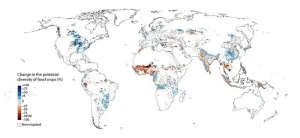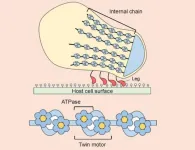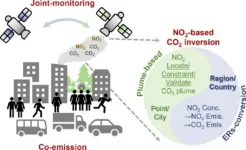(Press-News.org) Study: World’s critical food crops at imminent risk from rising temperatures
Global food security could be notably impacted by a marked decline in crop diversity if temperatures rise by more than 1.5°C, reveals new research.
Global warming is already reshaping our daily lives, with storms, floods, wildfires and droughts around the world. As temperatures continue to rise, a third of global food production could be at risk. Now, a new study in Nature Food offers a more precise picture of exactly where and how warming will affect our ability to grow food.
Researchers at Aalto University studied how future changes in temperature, precipitation and aridity will affect growing conditions of 30 major food crop species across the globe. They found that low-latitude regions face significantly worse consequences than mid- or high-latitudes. Depending on the level of warming, up to half of the crop production in low-latitude areas would be at risk as climate conditions become unsuitable for production. At the same time, those regions would also see a large drop in crop diversity.
‘The loss of diversity means that the range of food crops available for cultivation could decrease significantly in certain areas. That would reduce food security and make it more difficult to get adequate calories and protein,’ says Sara Heikonen, the doctoral researcher who led the study.
Up to half of the world’s food crop production may be affected
Warming will severely decrease the amount of global cropland available for staple crops –– rice, maize, wheat, potato and soybean –– which account for over two-thirds of the world’s food energy intake . In addition, ‘tropical root crops such as yam, which are key to food security in low-income regions, as well as cereals and pulses are particularly vulnerable. In sub-Saharan Africa, the region which would be impacted most, almost three quarters of current production is at risk if global warming exceeds 3°C,’ Heikonen says.
By contrast, mid- and high-latitude areas will probably retain their productive land overall, though zones for specific crops will change. These areas are also likely to see an increase in crop diversity. ‘For example, the cultivation of temperate fruits, such as pears, could become more common in more northerly regions,’ says Heikonen.
However, even if climatic conditions are favourable, other factors could hamper agriculture in these areas, says the study’s senior author, Professor Matti Kummu. ‘We showed that there’s climatic potential but, for example, warming might bring new pests and extreme weather events, which our model doesn’t include. So the situation isn’t really that black and white.’
Options for adaptation and mitigation
Many of the low-latitude regions threatened most by warming are already vulnerable in numerous ways. They face problems with food sufficiency, and economic and systemic forces make them less resilient than northern countries. Nevertheless, Kummu sees ways that these regions could, at least partly, meet the challenge.
‘In many low latitude areas, especially in Africa, the yields are small compared to similar areas elsewhere in the world. They could get higher yields with access to fertilisers and irrigation as well as reducing food losses through the production and storage chain. However, ongoing global warming will add a lot of uncertainty to these estimates and probably even more actions are needed, such as crop selection and novel breeding,’ he says. ‘But I always say that the modelling and analysis is the easy part –– understanding how to make the changes happen is the hardest part.’
While policy-makers in low-latitude countries should work to close those gaps, in mid- and high-latitude regions farmers and policy-makers need more flexibility, says Kummu. Warming will likely change which crops are grown in those areas, and further changes will come from the array of pressures on the global food system. Coping with those changes will require the ability to adjust and adapt as the consequences of climate change unfold.
‘If we want to secure our food system in the future, we need to both mitigate climate change and adapt to its effects,’ says Heikonen. ‘Even if the biggest changes are in equatorial regions, we will all feel the effects through the globalised food system. We need to act together to address these problems.’
END
Study: World’s critical food crops at imminent risk from rising temperatures
Global food security could be notably impacted by a marked decline in crop diversity if temperatures rise by more than 1.5°C, reveals new research.
2025-03-04
ELSE PRESS RELEASES FROM THIS DATE:
Chemistry: Triple bond formed between boron and carbon for the first time
2025-03-04
Boron, carbon, nitrogen and oxygen: these four elements can form chemical triple bonds with each other due to their similar electronic properties. Examples of this are the gas carbon monoxide, which consists of one carbon and one oxygen atom, or the nitrogen gas in the earth's atmosphere with its two nitrogen atoms.
Chemistry recognizes triple bonds between all possible combinations of the four elements – but not between boron and carbon. This is astonishing because there have long been stable double bonds between boron and carbon. In addition, ...
How a broken bone from arm wrestling led to a paradigm shift in mental health: Exercise as a first-line treatment for depression
2025-03-04
OTTAWA, Ontario, Canada, 4 March 2025 – In a comprehensive Genomic Press Interview published today in Brain Medicine, psychiatry resident Dr. Nicholas Fabiano reveals how a personal injury transformed into groundbreaking research on the intersection of physical and mental health. The interview showcases Dr. Fabiano's innovative work in lifestyle psychiatry and his mission to bridge the historical divide between physical and mental wellness.
"The arbitrary line we have drawn between mental and physical health is one of the biggest mistakes in medicine," Dr. Fabiano explains in the interview. His perspective was profoundly shaped by a broken bone due to ...
Alarming levels of microplastics discovered in human brain tissue, linked to dementia
2025-03-04
OTTAWA, Ontario, Canada, 4 March 2025 – In a comprehensive Commentary published today in Brain Medicine (https://doi.org/10.61373/bm025c.0020), researchers discuss alarming new evidence about microplastic accumulation in human brain tissue, providing critical insights into potential health implications and prevention strategies. This Commentary examines findings from a groundbreaking Nature Medicine article by Nihart et al. (2025) on bioaccumulation of microplastics in decedent human brains (https://doi.org/10.1038/s41591-024-03453-1).
The ...
Global neurology leader makes The Neuro world's first open science institute
2025-03-04
MONTREAL, Quebec, Canada, 4 March 2025 - In a comprehensive Genomic Press Interview, distinguished neurologist and geneticist Dr. Guy A. Rouleau, OC, OQ, FRCPC, FRSC, FAAN, outlines his transformative vision for accelerating neurological disease research through open science principles. As Director of The Neuro (Montreal Neurological Institute-Hospital) and Chair of McGill University's Department of Neurology and Neurosurgery, Dr. Rouleau is spearheading a revolutionary approach to scientific collaboration that could fundamentally change how brain disease research is conducted worldwide.
"We must be honest and ...
Alpha particle therapy emerges as a potent weapon against neuroendocrine tumours
2025-03-04
LONDON, UK, 4 March 2025 - In a comprehensive Genomic Press Viewpoint (review) article, researchers are shining a spotlight on a revolutionary approach to tackling neuroendocrine tumours (NETs), a rare but increasingly prevalent form of cancer. Published in Brain Medicine today, a peer-reviewed article titled "Alpha particle therapy for neuroendocrine tumours: A focused review" explores how targeted alpha therapy (TAT) could redefine treatment for patients where surgery is not an option. Authored by Dr. Kalyan M Shekhda, Dr. Shaunak Navalkissoor, and Emeritus ...
Neuroscience beyond boundaries: Dr. Melissa Perreault bridges Indigenous knowledge and brain science
2025-03-04
GUELPH, Ontario, Canada, 4 March 2025 – In an exclusive Genomic Press Interview, Dr. Melissa Perreault reveals how her research is reshaping neuroscience by merging cutting-edge science with Indigenous knowledge. As a professor in the Department of Biomedical Sciences at the University of Guelph and a member of the Royal Society of Canada, Dr. Perreault’s work spans neurobiology, ethical research practices, and the therapeutic potential of psychedelics—all while championing Indigenous representation in STEM.
Raised in a low-income, single-parent household, she was the first in her family to attend university. As she navigated academia, she encountered ...
Giant clone of seaweed in the Baltic Sea
2025-03-04
Researchers at the University of Gothenburg have discovered that what was previously thought to be a unique seaweed species of bladderwrack for the Baltic Sea is in fact a giant clone of common bladderwrack, perhaps the world's largest clone overall. The discovery has implications for predicting the future of seaweed in a changing ocean.
In the brakish waters of the Baltic Sea, bladderwrack is the dominant seaweed species as it is one of the few seaweed species that can tolerate low salinity.
The ...
Motion capture: In world 1st, M. mobile’s motility apparatus clarified
2025-03-04
Mycoplasmas, including bacteria that cause pneumonia in humans, are generally nonmotile, but Mycoplasma mobile, as the species name suggests, has been found in the gills of fish and seems to move by gliding along surfaces. The molecular structure that allows it to do so has for the first time been uncovered by a collaborative research group led by Osaka Metropolitan University Professor Makoto Miyata of the Graduate School of Science.
The OMU-led research team has been working since 1997 to clarify M. mobile’s motility mechanisms. ...
One-third of older Canadians at nutritional risk, study finds
2025-03-04
One-third of Canadian adults aged 55 or older are nutritionally at risk, potentially leading to increased hospital stays, more emergency visits and physician consultations for possible infections, a new study found.
The University of Waterloo researchers assessed data from more than 22,000 community-dwelling adults aged 55 and over from the Canadian Longitudinal Study on Aging. After an initial evaluation, they followed up with participants up to three years later to track their health-service use over the previous year.
Researchers used the SCREEN-8 tool (Seniors ...
Enhancing climate action: satellite insights into fossil fuel CO2 emissions
2025-03-04
Reliable and accurate monitoring of CO2 emissions is a cornerstone of effective climate change mitigation strategies. While traditional methods largely depend on ground-based measurements and bottom-up inventories, these approaches are often resource-intensive and prone to errors. Satellite Technology has emerged as a promising alternative, but the challenge remains in distinguishing anthropogenic emissions from natural processes. The long atmospheric lifetime of CO2 makes it difficult to pinpoint localized sources of emissions and track changes over time. Additionally, natural emissions and background concentrations ...
LAST 30 PRESS RELEASES:
Scalable and healable gradient textiles for multi‑scenario radiative cooling via bicomponent blow spinning
Research shows informed traders never let a good climate crisis go to waste
Intelligent XGBoost framework enhances asphalt pavement skid resistance assessment
Dual-function biomaterials for postoperative osteosarcoma: Tumor suppression and bone regeneration
New framework reveals where transport emissions concentrate in Singapore
NTP-enhanced lattice oxygen activation in Ce-Co catalysts for low-temperature soot combustion
Synergistic interface engineering in Cu-Zn-Ce catalysts for efficient CO2 hydrogenation to methanol
COVID-19 leaves a lasting mark on the human brain
Scientists use ultrasound to soften and treat cancer tumors without damaging healthy tissue
Community swimming program for Black youth boosts skills, sense of belonging, study finds
Specific depressive symptoms in midlife linked to increased dementia risk
An ‘illuminating’ design sheds light on cholesterol
Who is more likely to get long COVID?
Study showcases resilience and rapid growth of “living rocks”
Naval Research Lab diver earns Office of Naval Research 2025 Sailor of the Year
New Mayo-led study establishes practical definition for rapidly progressive dementia
Fossil fuel industry’s “climate false solutions” reinforce its power and aggravate environmental injustice
Researchers reveal bias in a widely used measure of algorithm performance
Alcohol causes cancer. A study from IOCB Prague confirms damage to DNA and shows how cells defend against it
Hidden viruses in wastewater treatment may shape public health risks, study finds
Unlock the power of nature: how biomass can transform climate mitigation
Biochar reshapes hidden soil microbes that capture carbon dioxide in farmland
Reducing saturated fat intake shows mortality benefit, but only in high-risk individuals
Manta rays create mobile ecosystems, study finds
Study: Mixed results in using lipoic acid to treat progressive multiple sclerosis
Norbert Holtkamp appointed director of Fermi National Accelerator Laboratory
New agentic AI platform accelerates advanced optics design
Biologists discover neurons use physical signals — not electricity — to stabilize communication
Researchers discover that a hormone can access the brain by hitchhiking
University of Oklahoma researcher awarded funding to pursue AI-powered material design
[Press-News.org] Study: World’s critical food crops at imminent risk from rising temperaturesGlobal food security could be notably impacted by a marked decline in crop diversity if temperatures rise by more than 1.5°C, reveals new research.









